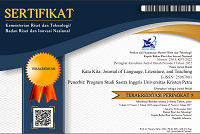Beauty Standard Construction and its Influence on Consumerism in Indonesia’s Next Top Model
DOI:
https://doi.org/10.9744/katakita.11.1.104-113Abstract
Indonesia's Next Top Model (INTM) is a television program that airs under a license from America's Next Top Model. Through this event, the participants are challenged to show their abilities and talents to become the best model. This event is also part of the symbolic recognition of who is the best and prettiest model. When the contestants' abilities are recognized, they will receive the title of Indonesia's Next Top Model. This thesis aims to analyze the beauty standards determined by the judges in the talent show, Indonesia's Next Top Model, as well as their influence on consumerism.
References
Idrus, I. I., Salman, D., & Agustang, A. (2020). Commodification of Environmental Discourse in the Process of Producing Space in Bukit Baruga Housing, Makassar. In IOP Conference Series: Materials Science and Engineering (Vol. 1125, pp. 1–9).
Kuhumba, K. S. (2018). Hyper-consumerism : Rethinking Virtue Ethics and Moral Solution in Contemporary Society. Journal of Sociology, Psychology and Anthropology in Practice, 9(2), 114–126.
Middleton, K., Turnbull, S., & de Oliveira, M. J. (2020). Female role portrayals in Brazilian advertising: are outdated cultural stereotypes preventing change? International Journal of Advertising, 39(5), 679–698.
Musin, J. (2013). Docile and Disciplined: What it Takes to Become America’s Next Top Model. Colloquy Text Theory Critique. 26: 23-47. Monash University
Octaviana, R. (2020). Konsumerisme Masyarakat Modern dalam Kajian Herbert Marcuse. JAQFI: Jurnal Aqidah Dan Filsafat Islam, 5(1), 121–133.
Pratiwi, R. Z. B. (2018). Perempuan dan Kontes Kecantikan (Analisis Mengenai Konstruksi Citra dalam Bingkai Komodifikasi). Jurnal An-Nida, 10(2), 133–143.
Rachel, R., & Rangkuty, R. P. (2020). Konsumerisme dan Gaya Hidup Perempuan di Ruang Sosial: Analisis Budaya Pembedaan Diri di Lingkungan Fisip UNIMAL. Jurnal Ilmu Sosial Dan Ilmu Politik Malikussaleh (JSPM), 1(1), 97–113.
Syafrini, D. (2014). Perempuan dalam Jeratan Eksploitasi Media Massa. Humanus, XIII(1), 2014.
Widuhung, S. M., & Sartika, R. (2022). Tren Penggunaan Endorser Pria Dalam Iklan Kecantikan (Kajian Semiotika Iklan Nature Republic Versi EXO). Jurnal Public Relations-JPR, 3(1), 1–8.
Winarni, R. W. (2010). Representasi Kecantikan Perempuan dalam Iklan. Deiksis, 2(2), 134–152.
Worotitjan, H. G. (2014). Konstruksi Kecantikan dalam Iklan Kosmetik Wardah. Jurnal E-Komunikasi, 2(2), 1–10.
Downloads
Published
Issue
Section
License
Authors who publish with this journal agree to the following terms:- Authors retain copyright and grant the journal right of first publication with the work simultaneously licensed under a Creative Commons Attribution License that allows others to share the work with an acknowledgement of the work's authorship and initial publication in this journal.
- Authors are able to enter into separate, additional contractual arrangements for the non-exclusive distribution of the journal's published version of the work (e.g., post it to an institutional repository or publish it in a book), with an acknowledgement of its initial publication in this journal.
- Authors are permitted and encouraged to post their work online (e.g., in institutional repositories or on their website) prior to and during the submission process, as it can lead to productive exchanges, as well as earlier and greater citation of published work (See The Effect of Open Access).














